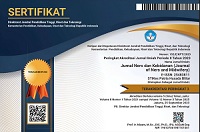The Analysis of Factors in Children’s Dietary Patterns That Affect Physical Fitness
DOI:
https://doi.org/10.26699/jnk.v11i3.ART.p294-300Keywords:
Eating Pattern, Fitness, ChildrenAbstract
Fitness for children is related to optimal physical condition. Fitness influences mental and social development, especially children's concentration and learning abilities. Fitness must be maintained to support activities. Diet is a supporting factor for children's physical fitness. Diet is the foundation for long-term health. The research aimed to determine factors related to eating patterns that influence children's physical fitness. The research design was cross-sectional. The research population was school children aged 10-12 years totaling 96 students in 2023 using the total sampling method. The independent variables were BMI (Body Massa Index), physical activity, and rest, and the dependent variable was the child's physical fitness. The instrument used the Physical Activity Questionnaire to measure activity, eating patterns using Food Frequency, rest using The Pittsburgh Sleep Quality Index, and physical fitness, calculated using the Technical Guidelines for Health Screening and Periodic Examination of School-Age Children and Adolescents in 2018. The analysis test used linear regression (P<0.05) to determine the relationship between factors related to eating patterns and influencing children's physical fitness. The results of the study showed that there was no relationship between BMI (p 0.661), physical activity (0.783), and rest (p 0.756) on eating patterns. An eating pattern is a significant mediator for physical activity and rest but not for BMI (p 0.733) on children's physical fitness. Rest (p 0.000) and physical activity (p 0.004) influence children's physical fitness. BMI does not measure the position and location of fat, so people with the same BMI have different fitness levels.
References
Arslan, N., Bozkır, E., Koçak, T., Akin, M., & Yilmaz, B. (2024). From Garden to Pillow: Understanding the Relationship between Plant-Based Nutrition and Quality of Sleep. Nutrients, 16(16), 1–19. https://doi.org/10.3390/nu16162683
Burns, R. D., Brusseau, T. A., Fu, Y., & Hannon, J. C. (2015). Associations between Health-Related Fitness and Cardio-Metabolic Blood Profiles in Low-Income Children. Open Journal of Preventive Medicine, 05(09), 370–376. https://doi.org/10.4236/ojpm.2015.59041
Chatterjee, P., & Nirgude, A. (2024). A Systematic Review of School-Based Nutrition Interventions for Promoting Healthy Dietary Practices and Lifestyle Among School Children and Adolescents. Cureus, 16(1), 1–17. https://doi.org/10.7759/cureus.53127
De Miguel-Etayo, P., Gracia-Marco, L., Ortega, F. B., Intemann, T., Foraita, R., Lissner, L., Oja, L., Barba, G., Michels, N., Tornaritis, M., Molnár, D., Pitsiladis, Y., Ahrens, W., & Moreno, L. A. (2014). Physical fitness reference standards in European children: The IDEFICS study. International Journal of Obesity, 38, S57–S66. https://doi.org/10.1038/ijo.2014.136
García-Hermoso, A., Ezzatvar, Y., López-Gil, J. F., Ramírez-Vélez, R., Olloquequi, J., & Izquierdo, M. (2022). Is adherence to the Mediterranean diet associated with healthy habits and physical fitness? A systematic review and meta-Analysis including 565Â 421 youths. British Journal of Nutrition, 128(7), 1433–1444. https://doi.org/10.1017/S0007114520004894
Hariani, R., Bardosono, S., Djuwita, R., Sutandyo, N., Kumala, M., Sungkar, A., & Sekartini, R. (2016). Paediatrica Indonesiana. 56(3), 134–138.
Jebeile, H., Kelly, A. S., O’Malley, G., & Baur, L. A. (2022). Obesity in children and adolescents: epidemiology, causes, assessment, and management. The Lancet Diabetes and Endocrinology, 10(5), 351–365. https://doi.org/10.1016/S2213-8587(22)00047-X
Khanna, D., Peltzer, C., Kahar, P., & Parmar, M. S. (2022). Body Mass Index (BMI): A Screening Tool Analysis. Cureus, 14(1994), 1–6. https://doi.org/10.7759/cureus.22119
Martín-Rodríguez, A., Bustamante-Sánchez, Á., Martínez-Guardado, I., Navarro-Jiménez, E., Plata-SanJuan, E., Tornero-Aguilera, J. F., & Clemente-Suárez, V. J. (2022). Infancy Dietary Patterns, Development, and Health: An Extensive Narrative Review. Children, 9(7), 1–21. https://doi.org/10.3390/children9071072
Mutohir, T. C., Lutan, R., Maksum, A., Kristiyanto, A., & Akbar, R. (2023). Kebugaran Jasmani dan Generasi Emas 2045. Deputi Bidang Pembudayaan Olahraga Kementrian Pemuda Dan Olahraga Republik Indonesia, November, 110.
Pesta, D. H., & Samuel, V. T. (2014). A high-protein diet for reducing body fat: Mechanisms and possible caveats. Nutrition and Metabolism, 11(1), 1–8. https://doi.org/10.1186/1743-7075-11-53
Pineda, K. L. L., Gonzalez-Suarez, C. B., Espino, R. V. S., Escuadra, C. J., Balid–Attwell, S. A., Devora, K. B., & Mendoza, D. S. (2020). Eating Habits of College Students in Relation to Obesity. Journal of Medicine, University of Santo Tomas, 4(2), 500–509. https://doi.org/10.35460/2546-1621.2019-0018
Prianto, D. A., Utomo, M. A. S., Abi Permana, D. A. P., Mutohir, T. C., & Suroto. (2022). Survey Tingkat Kebugaran Jasmani dan Faktor Yang Mempengaruhi Tingkat Kebugaran Jasmani Siswa Sekolah Menengah Pertama di Sidoarjo. Jurnal Segar, 10(2), 49–56. https://doi.org/10.21009/segar/1002.01
Pujari, S. N. and D. H. (2023). Impact of Nutrition in Fitness Development and Performance Enhancement for Athletes. International Journal of Advanced Research in Science, Communication and Technology (IJARSCT), 3(1), 521–525. https://doi.org/DOI: 10.48175/IJARSCT-13173
Sánchez-Delgado, A., Pérez-Bey, A., Izquierdo-Gómez, R., Jimenez-Iglesias, J., Marcos, A., Gómez-Martínez, S., Girela-Rejón, M. J., Veiga, O. L., & Castro-Piñero, J. (2023). Fitness, body composition, and metabolic risk scores in children and adolescents: the UP&DOWN study. European Journal of Pediatrics, 182(2), 669–687. https://doi.org/10.1007/s00431-022-04707-1
Sénéchal, M., Hebert, J. J., Fairchild, T. J., Møller, N. C., Klakk, H., & Wedderkopp, N. (2021). Vigorous physical activity is important in maintaining a favourable health trajectory in active children: the CHAMPS Study-DK. Scientific Reports, 11(1), 1–8. https://doi.org/10.1038/s41598-021-98731-0
Sutjiati, E., & Saputri, D. A. (2022). Eating Habits, Intake of Energy and Nutrients, and Physical Activity, and Blood Glucose Levels Overweight Adolescents in Blitar City, East Java. Jurnal Gizi Dan Pangan Soedirman, 6(2), 1. https://doi.org/10.20884/1.jgipas.2022.6.2.5829
Swanson, T. J. S. and C. (2021). A Runner’s High for New Neurons? Potential Role for Endorphins in Exercise Effects on Adult Neurogenesis. Biomocules, 11, 2–15. https://doi.org/https://doi.org/10.3390/biom11081077
TG, S. (2018). Endorphins–A Novel Hidden Magic Holistic Healer. Journal of Clinical & Cellular Immunology, 09(02), 9–10. https://doi.org/10.4172/2155-9899.1000547
Utesch, T., Dreiskämper, D., Naul, R., & Geukes, K. (2018). Understanding physical (in-) activity, overweight, and obesity in childhood: Effects of congruence between physical self-concept and motor competence. Scientific Reports, 8(1), 1–10. https://doi.org/10.1038/s41598-018-24139-y
Wahl, D. R., Villinger, K., König, L. M., Ziesemer, K., Schupp, H. T., & Renner, B. (2017). Healthy food choices are happy food choices: Evidence from a real life sample using smartphone based assessments. Scientific Reports, 7(1), 1–8. https://doi.org/10.1038/s41598-017-17262-9
Westerterp, K. R. (2013). Physical activity and physical activity induced energy expenditure in humans: Measurement, determinants, and effects. Frontiers in Physiology, 4 APR(April), 1–11. https://doi.org/10.3389/fphys.2013.00090

Downloads
Published
How to Cite
Issue
Section
License
Copyright (c) 2024 Jurnal Ners dan Kebidanan (Journal of Ners and Midwifery)

This work is licensed under a Creative Commons Attribution-ShareAlike 4.0 International License.


 Google Scholar
Google Scholar Sinta
Sinta ORCID
ORCID
 Google Scholar
Google Scholar Sinta
Sinta ORCID
ORCID

 Sinta
Sinta



